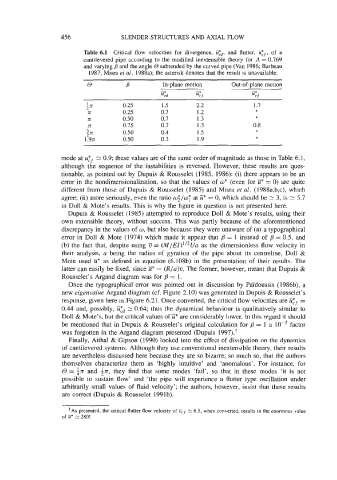Page 486 - Fluid-Structure Interactions Slender Structure and Axial Flow (Volume 1)
P. 486
456 SLENDER STRUCTURES AND AXIAL FLOW
Table 6.1 Critical flow velocities for divergence, ZY;,, and flutter, E:,., of a
cantilevered pipe according to the modified inextensible theory for A = 0.769
and varying B and the angle 0 subtended by the curved pipe (Van 1986; Barbeau
1987; Misra et al. 1988a); the asterisk denotes that the result is unavailable.
0 B In-plane motion Out-of-plane motion
- -*
1;
4d ‘rf Ucf
;IT 0.25 1.5 2.2 1.7
n 0.25 0.7 1.2 *
n 0.50 0.7 1.3 *
n 0.75 0.7 1.3 0.8
;n 0.50 0.4 1.5 *
1.9n 0.50 0.3 1.9 *
mode at ii:f 2 0.9; these values are of the same order of magnitude as those in Table 6.1,
although the sequence of the instabilities is reversed. However, these results are ques-
tionable, as pointed out by Dupuis & Rousselet (1985, 1986): (i) there appears to be an
error in the nondimensionalization, so that the values of w* (even for U* = 0) are quite
different from those of Dupuis & Rousselet (1985) and Misra et al. (1988a,b,c), which
agree; (ii) more seriously, even the ratio w;/w; at U* = 0, which should be 2: 3, is 2: 5.7
in Doll & Mote’s results. This is why the figure in question is not presented here.
Dupuis & Rousselet (1985) attempted to reproduce Doll & Mote’s results, using their
own extensible theory, without success. This was partly because of the aforementioned
discrepancy in the values of w, but also because they were unaware of (a) a typographical
error in Doll & Mote (1974) which made it appear that p = 1 instead of j3 = 0.5, and
(b) the fact that, despite using ;ij = (M/EZ)’/2Ua as the dimensionless flow velocity in
their analysis, a being the radius of gyration of the pipe about its centreline, Doll &
Mote used ii* as defined in equation (6.108b) in the presentation of their results. The
latter can easily be fixed, since U* = (R/a)V. The former, however, meant that Dupuis &
Rousselet’s Argand diagram was for B = 1.
Once the typographical error was pointed out in discussion by Paidoussis (1986b), a
new eigenvalue Argand diagram (cf. Figure 2.10) was generated in Dupuis & Rousselet’s
response, given here as Figure 6.21. Once converted, the critical flow velocities are ii:f =
0.44 and, possibly, ii:d 2: 0.64; thus the dynamical behaviour is qualitatively similar to
Doll & Mote’s, but the critical values of ii* are considerably lower. In this regard it should
be mentioned that in Dupuis & Rousselet’s original calculation for B = 1 a lop2 factor
was forgotten in the Argand diagram presented (Dupuis 1997).+
Finally, Aithal & Gipson (1990) looked into the effect of dissipation on the dynamics
of cantilevered systems. Although they use conventional inextensible theory, their results
are nevertheless discussed here because they are so bizarre; so much so, that the authors
themselves characterize them as ‘highly intuitive’ and ‘anomalous’. For instance, for
0 = $IT and ~TC, they find that some modes ‘fail’, so that in these modes ‘it is not
possible to sustain flow’ and ‘the pipe will experience a flutter type oscillation under
arbitrarily small values of fluid velocity’; the authors, however, insist that these results
are correct (Dupuis & Rousselet 1991b).
+As presented, the critical flutter flow velocity of Gcf E 6.5, when converted, results in the enormous value
of iP 2 280!

